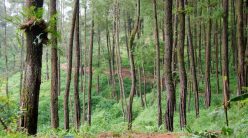by Elizabeth Serai James
jphpk.gov.my
KUCHING – The new approach to the management of sustainable harvest of the Black-nest swiflets at Niah National Park has been a success after two years of implementation.
The chief technical adviser for Danish International Development Assistance (DANIDA)/Support to Wildlife Master Plan Implementation (SWMPI) Project, Julian T Inglis, disclosed this in an interview with Tribune at his office yesterday.
Niah Cave used to be a major source of the ‘black’ edible bird’s nests produced by the Blacknest Swiflets (Aerodramus maximus) in the 80s. However, the swiflets population had declined tremendously over the past few decades, he said.
According to the DANIDA/SWMPI census in 2002, 65,000 bird’s nests were found in Niah Cave compared to 1,700,000 nests found in the first census carried out by Banks in 1935, a decrease of about 96 percent.
Inglis pointed out that a species that had apparently withstood traditional exploitation for more than a century was diminishing at an alarming rate simply because of uncontrollable and indiscriminate harvesting practices carried out in recent years.
He said: “In addition, weak management or lack of initiatives from the licensees, rampant poaching as well as disputes over ownership claims and disunity among the local communities worsened the situation.”
Responding to widespread concerns, the State government took a drastic measure to ban all nest harvesting activities at Niah National Park in April 1989 and extended the ban for another four years in 1992. However, by 1996, it was clear that the ban was not effective, noted Inglis.
The ban was lifted in 1997 with the management of nest-yielding caves reverting to the licensees. But the approach did not improve the situation either, he said, adding that both measures to save the Black-nest swiflets had failed.
According to Inglis, there was also no proper management and regulation in the Cave which led to the accumulation of rubbish over the years, graffiti on cave walls, illegal immigrants working in caves, nest poaching, gambling, drug abuse by workers and noise such as loud music.
He stressed that the previous measures failed because the influential role of the bird’s nest traders who controlled the industry was not recognised and they had no sense of ‘ownership’.
However, under the new management approach a comprehensive study was drawn up on the breeding biology of the Black-nest swiflets at the Cave.
He explained: “The new approach, implemented two years ago, is acceptable to the State government as well as the local community. Under the approach, harvesting of nests is not allowed four months in a year.
“After four months, licensees are allowed to harvest every month.”
He pointed out that “it takes an average of 30 days for each pair of Black-nest swiflet to lay one egg and it will take another 25 days to incubate one egg. A baby bird needs at least 45 days to grow big. Thus, it takes four months for the young birds to mature.”
The breeding cycle of Black-nest swiflets – from its ability to fly to building its own nest – is about one year, explained Inglis.
The date for the “closing of Niah Cave from harvesting activity” is recommended by the Forestry Department through dialogues held with the local communities.
“Within that time, the Cave will be guarded by Cave guards and bird’s nests traders will give loans to their workers as compensation for the four-month inactivity during which they are not allowed to harvest,” said Inglis.
Last year, the closure of the Cave was from February 1 to May 23; this year the closure is from January 1 to May 1.
He said by the time the Cave was reopened for harvesting activity, the nests would be “fully matured”, enhancing the quantity of the harvest.
According to DANIDA/SWMPI project community adviser, Dr Lim Chan Koon, the Black-nest swiflet is the only species of commercial value in Niah Cave.
Lim said apart from the management plan, the new approach was to work together with the local communities and stakeholders.
“We hold dialogues and gatherings with all the stakeholders. The stakeholders are the licensees, the bird’s nest traders, the cave guards and cottage bird’s nest processors and the Forestry Department,” said Lim.
According to him, some of the bird’s nests are sold locally. Most, however, are exported to Hong Kong and Singapore.
He said: “One kg of freshly-collected bird’s nests can fetch between RM900 and RM1500, depending on the quality. There is a huge demand for the commodity.”





